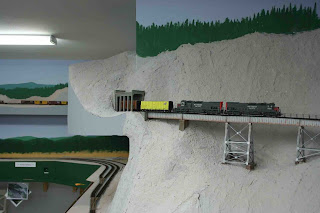My terrain forming efforts have enclosed the full mainline with completion of the ridge over Tunnel 7. This is the tunnel at the RR-West end of Shady Creek Trestle. This was the final mainline tunnel to be enclosed. All ten modeled tunnels have been encased.
Closing in Tunnel 7 awaited fine-tuning of the roadbed in this area resulting from the trestle installation. In contrast to the other trestles on my railroad, I had to cut-in a new spine for Shady Creek. Inevitably, this upset the roadbed alignment in the area, notably through the area to be enclosed as Tunnel 7. It took a couple of fine-tuning efforts and then successful train operations through the area by my regular operating crew to approve this area for tunnel enclosure. The key test of the roadbed was that the operation needed to be done by someone other than me, the builder. This is similar to the concept that one cannot proof read one's own writing.
An added challenge for this terrain effort was that the RR-East end of the tunnel sits atop the area where the terrain from both lower and upper deck merge. The transition is necessary but complicated by minimal scene depth. This leads to vertical terrain walls. I needed to make it somewhat believable and then distract attention to either side. Fortunately, Shady Creek Trestle dominates the scene, so I will live with the vertical rock walls. Subsequent addition of trees on the lower deck should help.
Construction of the tunnel enclosure followed my standard pattern, documented in blog posts over the past year. The first step was to ballast the track through the tunnel. Second, a tunnel liner was constructed for the inner tunnel. The portals and end liners were built and placed during my earlier tunnel end effort. Multiple posts a year ago covered the portals, liners and rock sheds.
Tunnel 7 foundations. The tunnel liner is in place and the first step off fascia panel installation has been done. Still to come is curving the lower tail of the fascia around to attachment to the wood blocks just below the RR-East face of the rock shed portal.
Closing in the tunnel with slabs of insulation foam began with contour supports on the back wall and the inside of the front fascia. Then, it was a simple job to fill in foam slabs around the tunnel portals and then build the ridge. Once the basic landform was created with slabs of insulating foam, spray foam was applied to fill gaps and add additional rock formations. The foam was then carved to the final configuration. This was particularly important with the spray foam, as it expanded considerably after the initial application.
The fascia panel has been fully-mounted. Contour panels are mounted on the wall (right) and back of the fascia panel (left). The RR-West portal has been encased in insulating foam slabs and panels for the ridge now span between the fascia and wall.
Insulating foam slab construction for the RR-West portal of Tunnel 7.
Spray foam fills the gaps and helps further form the terrain.
RR-West McCredie Springs terrain, including the transition to the upper deck terrain.
Sculptamold applied to the slab foam base.
SP9320E operating as the 05-RVEUY <Roseville to Eugene manifest freight> passes through Tunnel 7 and onto Shady Creek Trestle.
SP9320E stretched out from Shady Creek Trestle back through Tunnels 7 and 5.
Tying it all together, SP9320E is shown below entering the RR-West end of McCredie Springs while SP8283 climbs out of Cruzatte and through Tunnel 7.









No comments:
Post a Comment